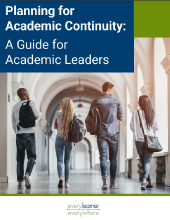Summary
Established academic continuity plans allow colleges and universities to use their resources to manage disruptions, rather than using them to develop new plans and policies for each disruption event. While mobile communication and digital learning tools are widely used today on U.S. campuses, these tools have limited use in times of academic disruption without a plan on how to use them to maintain or resume academic operations. Having digital learning tools available to faculty is not useful if those individuals don’t know how to use them, and digital learning tools do not serve students who cannot afford to access them. Academic continuity planning is an essential component of the business continuity plans of colleges and universities, and yet hundreds of schools were not prepared for the months-long academic disruption caused by lockdowns in the wake of the COVID-19 pandemic.
This guide presents results from an analysis of 100 academic continuity plans at U.S. colleges and universities. The results form the basis for recommended academic continuity plan best practices, tools, and templates academic leaders can use to maintain a plan that can be used in both short-term and long-term circumstances. We believe that digital learning tools and platforms provide a solution for moving learning environments online in times of academic disruption. But they also play a bigger role in academic continuity planning. Much like required fire drills to prepare a campus community for a fire emergency, higher education needs to maintain a readiness to face disruptions to academic continuity.
Details
- Year Published : 2023
- Month Published : August
